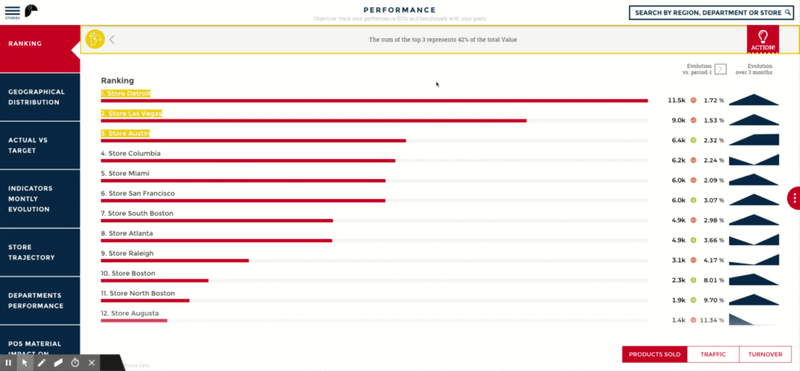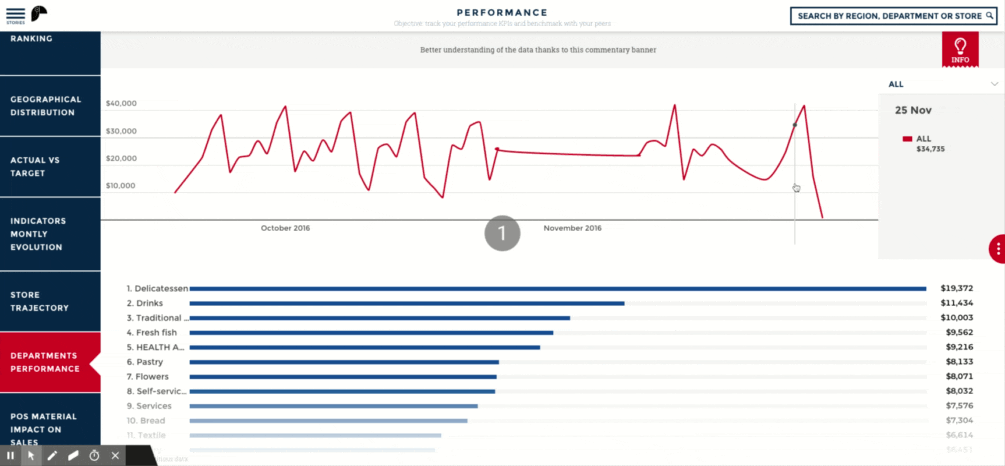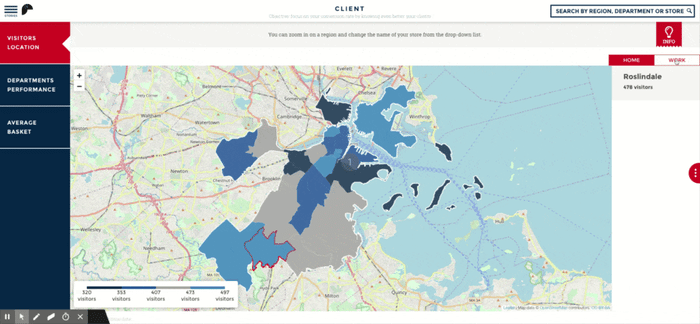
Margin compression and the need for data-driven franchise business
Since last March, the world has officially entered a state of a health emergency, with serious repercussions on business activity, including for franchised networks. According to a survey held by the French Franchise Federation among franchisors and franchisees in April: 75.4% of respondents said they had lost more than 70% of their turnover in April 2020 compared to the same month in 2019.
However, this particular period is also a time of accelerating change, synonymous with positive adaptations and innovations that deserve to be highlighted.
In this climate, the right data at the right time could make a massive difference. Inevitably, retailers are scrambling to invest in data-driven retail technology, eager to democratize access to insights.
But how far has this vision been realized?
Digital transformation in retail remains limited to the C-level
A 2019 study by Deloitte found that at least a quarter of retailers have achieved significant levels of maturity on their digital transformation journey, owing primarily to the role of data. This is because data can help you:
- Understand customer sentiment and boost experiences, at par with e-commerce benchmarks
- Optimize core operations and sales activities to reduce waste
- Discover opportunities for generating revenue, such as untapped markets or new products
On the flip side, access to data-driven retail insights continues to be constrained to a small circle. Over 50% of organizations don’t have the in-house talent needed to analyze datasets, even when they are abundantly available. Bloomberg found that data scientists are now in high demand for physical stores as they look at unearthing value from the reams of data accessible at your typical retail chain.
But it isn’t always possible to station an analytics expert on every floor. And it isn’t advisable to keep the benefits of data-driven retail within a closed circle, at the C-level or those stakeholders conversant in data science. Storytelling bridges this gap between retail data possibilities and on-floor executive requirements.
Data storytelling could answer some of the most common pain points facing the retail industry today, equipping every stakeholder to make better decisions, and contribute to a higher bottom line.
4 challenges in franchise management and how a Data Storytelling dashboard can help
Gartner reaffirms that data & analytics is a top priority for retail CIOs. It’s vital to ensure that the benefits of data & analytics percolate down to the grassroots levels to enable maximum ROI. Here’s how data storytelling makes this possible.
1. Sync your franchise operations with your headquarters
More often than not, organizational objectives are captured in a high-level policy document, followed up by formal training and reviews. Headquarters’ executives have little to no visibility on how precisely their performance is meeting these organizational KPIs. This impacts sales and the franchise efficiency until the next review cycle – and by that time, it might be too late.
Storytelling takes ownership of data-driven retail insights away from the sole hands of technical teams. Every employee and manager can view everyday operations, common problem areas, and how a specific factor influences the bottom line.
Take the case of perishable goods: improperly managed perishable goods and food waste can significantly dent your corporate image, not to mention reduce net revenues. It isn’t enough to simply outline a no-waste policy – employees in charge of managing supplies must be aware of how their activities lend to or take away from the bottom line.
A data dashboard that showcases precisely how expired products, discounts required to move perishable goods and the transport of wasted items all together impact profitability.
You can even enable drill-down for each category, helping personnel target specific issues thanks to a drill-down view of the expired products variable.
Wonder how it looks in a Dashboard? Watch it in a complete video: Toucan - Food Chain and Restaurant - Dashboard creation | 17:36
2. Share best practices across Franchisee stores
A big part of data-driven retail is unlocking the same level of performance and profitability across multiple outlets. Success cannot be dependent on individual variables and must be replicated across different locations.
Data storytelling makes the benefits of digital transformation available across the retail chain, highlighting which stores are performing well, key success factors, and negative trends that need to be addressed. Outlets that rank at the top of your performance list should act as inspiration for the entire retail ecosystem.
For example, a country-wide data dashboard can condense complex performance information into an easy-to-read snapshot.

Here, you can see the top-performing stores, the number of products sold, and even a three-month performance overview, using the sparklines on the right. Next, retail employees can analyze the number of products sold via-a-vis in-store traffic – in this dashboard, South Boston ranks #7 in terms of product sales, but #2 in terms of traffic.
The dashboard reveals the lack of correlation between sales and traffic.
Clearly, stakeholders at the South Boston locations should conduct knowledge transfers with stores in the top quartile to learn how to convert traffic into revenues. Storytelling makes data-driven retail insights like this accessible even to lay-users.
3. Empower operations managers to make more profitable decisions for the franchise management
Data isn’t just about guiding high-level strategies. It can influence micro-decisions that retailers take every day and incrementally improve store performance. Data storytelling makes it easier to establish this culture of informed decision-making, reducing pressures on the C-suite, and encouraging accountability at every step of the value chain.
For example, a store manager could be better positioned to implement a data-driven insight into retail departments. They are more familiar with a franchise’s requirements and have a better grasp of how myriad operational factors shape performance. A storytelling dashboard compresses data over long periods (weeks or even months) to give a bird’s eye view of department-specific performance.

The manager can then select below-average or above-average scenarios to pinpoint which variables made a difference. In other words, data-driven retail insights inspire operational stakeholders to ask the right questions and thereby unlock value-generating answers.
4. Convert customer data into actionable insight for franchisees management
In today’s experience-led economy, customer insights are key to sustained profitability and market leadership. Global retail majors like Amazon or Target have set very high benchmarks in customer-centricity, and most retailers are struggling to keep up. Data storytelling lets you capture information from a variety of sources – from in-store surveys to email-based net promoter scores – and extracts valuable ideas.
Let’s look at a highly specific use case: a retailer expanding into a new geography must quickly understand buying patterns in the region, as well as competitor stores appearing in close proximity. Managers can take data from telecom, public records, and third-party sources to understand the exact distribution of customers in that geography.

While this sounds complex on the surface, storytelling condenses what would be multiple spreadsheets, into a visually readable map. And this happens without compromising on granularity – by drilling down into each location, the store manager can reveal further data around their own store.
Why the future of the franchise will be shaped by data stories
Storytelling places data into the right context, without any need for human intervention or data science expertise. From fresh graduates who joined a store just last week, to non-digital-native operations managers who’ve been at your organization for decades, everyone can draw insights and contribute to your vision of data-driven retail.
The data is out there and it’s ready to speak; all you need to do is create stories that help you listen.


